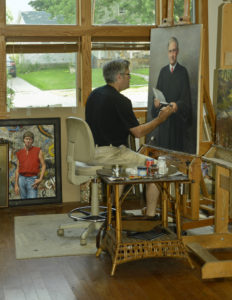
In the art studio, students may listen to music through earphones, if it helps them concentrate. But junior Kylie Diehl said she sometimes leaves the earphones out, so she can hear the master work with his students.
“He has all these interesting tidbits about art history and technique suggestions,” she said. “He taught me everything I know about painting.”
Students have relied on Professor of Art Sam Knecht’s encouragement and expertise for 38 years, but Knecht is retiring from his full-time teaching position at Hillsdale College at the end of the fall semester. He said he plans to focus on his career as a visual artist. Although Knecht said he hopes to teach a class or two every semester, he will be far less involved with the department.
Knecht has taught more than 1,500 students — many who are now college professors or influential in the 2D and 3D arts — and 18 different classes during his time at Hillsdale. That, he said, gives him more pride than any of his other achievements.
Those include earning awards from the Portrait Society of America, the American Society of Portrait Artists, the Butler Institute of American Art, and the Michigan Water Color Society. He also almost singlehandedly expanding the art program into the full-fledged academic department it is today, he said.
“My vision for the department from the beginning, which I was confident would resonate with the greater college, would be to direct and grow the department in a direction that not only taught traditional skills in studio classes but also would continue and enhance art history teaching,” Knecht said.
Professor of Music Melissa Knecht, his wife, said the department was limited and had a heavy focus on ceramics before her husband became involved.
“He’s quietly built that art program from just kind of a craft featuring ceramics to a serious program,” she said. “He designed the curriculum, he hired everyone that’s on the faculty, and all of them are highly successful.”
Despite resigning his full-time position, Knecht will still teach one or two classes each semester to make his retirement as seamless a transition as possible, he said. He passed the art department chairmanship onto his colleague, Associate Professor of Art Barbara Bushey, three years ago, as his first step toward retirement.
Knecht said he teaches a unique, “counter-cultural” realist style of art that fits with Hillsdale’s philosophy. It is something other universities have largely forgotten in favor of “individual experimentation,” he said.
“The best realist art holds up a mirror to the beauty of nature and humankind and has a power to tell stories,” he said. “I really love art that celebrates human existence and the beauty of the world.”
That is what he aims to teach his students to appreciate, Melissa Knecht said.
“His art is to capture a moment in time and let the person feel the essence,” she said. “You can’t get that with a photograph the same way you can with an oil painting. There’s a richness and excitement with the brush. You can feel the moment.”
But beyond his students, Sam Knecht has also loved working for the college itself, his wife said.
“His first priority is his job at the college,” Melissa Knecht said. “He really loves this place. He understands its philosophy, and he spends a lot of time talking about it to donors.”
Sam Knecht has painted many of the art pieces that decorate Hillsdale, including portraits of donors and his wife’s violin students. His most famous contribution is the “Signing of the Constitution” that hangs in the Allan P. Kirby Jr. Center for Constitutional Studies and Citizenship in Washington, D.C. It also adorns the cover of the Constitution reader.
After he retires, Sam Knecht said he plans to use the extra time to focus on painting similar projects.
“I would love to do another historical or religious painting that involved a similar intensity of research planning and execution that would serve a high cause, something that would be perhaps narrative, that would challenge all aspects of my painting skill,” he said.

